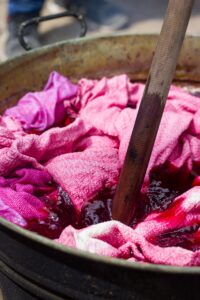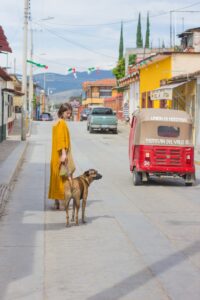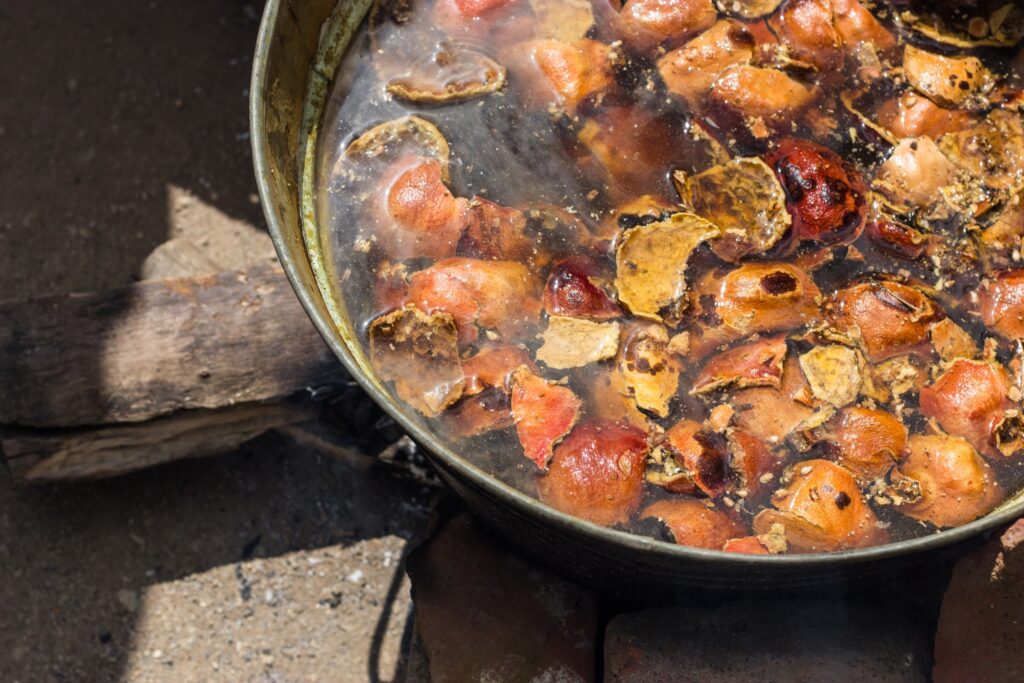Back in March 2020, as the COVID-19 pandemic set in and cities all across the world shut down, Americans began baking bread. It seemed that sourdough—with its complex but achievable fermentation process, its geeky terminology and technicalities to master, and its wild aliveness—was just the thing to soothe our anxious minds, filling the square walls of our homes with the sweet scent of healthful decadence as crusts bloomed and crisped in the oven. Perhaps it wasn’t just the comfort we craved, but also the collectively shared sense of self-reliant resilience—a reminder that even when there was not a roll of toilet paper nor a box of pasta to be found at any grocery store within a five-mile radius, sustenance could still be made with the simplest ingredients, by hand, using basic chemistry that dates back to the Stone Age.
But it wasn’t just the sourdough. We started tending to houseplants with a newly obsessive fervor. We adopted dogs at record rates. In other words, we nested. Trapped indoors, we surrounded ourselves with signs of life, seeming to understand that we had to engage our bodies’ senses in order to cultivate a grounding combination of coziness and vibrancy. With no guests allowed in and nowhere else to go, how might we make our houses feel like actual homes?
Personally, I skipped the sourdough and instead turned to tortillas. Quarantined on a farm in Oregon with my partner and two close friends who own the property, I measured cupfuls of dried corn from the garden’s stalks, simmered and soaked them in a mixture of water and slaked lime, rubbed off as many of the hulls as I could manage, and ground the kernels in a food processor to make my best attempt at masa. I got the cast-iron tortilla press from my car—the one I lugged back from Oaxaca, Mexico several years ago—and got to work, slapping tortilla after tortilla onto the hot skillet. The steam rose around me as the masa puffed and perfumed the kitchen, and my bodily memory tugged me back to a different time, when travel and interpersonal connection (in a non-Zoom capacity) weren’t such impossibilities.






It was October 2017, and I’d flown to Oaxaca on a freelance assignment. I was there to photograph a week-long weaving retreat led by Thread Caravan, a group that hosts all-inclusive, interactive crafting trips in direct collaboration with local artisan communities around the globe. In Oaxaca, Thread Caravan partners with Vida Nueva, a cooperative of women weavers who are based just outside the capital city in a small Zapotec town called Teotitlán del Valle, which is known for its textiles.
Vida Nueva’s founder, Pastora, welcomed us into the co-op’s workshop, which occupied the central courtyard of her home. It was mostly raw dirt, adorned with an array of potted plants and shaded by wild trees and brush. Water boiled in well-worn metal pails, balanced atop open fires, with skeins of freshly dyed yarn dangling from clotheslines and piled up in every corner.
A seating and dining area had been arranged on a cool tile floor underneath a wide roof, with a long wooden table down the center. Intricately woven rugs were fixed on the mint green stucco wall as an artful backdrop, and cactus paddles hung glimmering with bright white constellations of cochineal, the tiny insects traditionally ground up to create a vibrant red pigment.
Pastora grinned, offering each of us a warm bienvenida as we stepped into the space that seemed to thrum with an honest, unpretentious sort of creative vitality. Once proper introductions were exchanged via Thread Caravan’s translator, she walked us back out again, guiding us into the surrounding hillsides to forage for plants that could be transformed to natural dyes. We followed as she led us through open fields and groves of trees, and across a gurgling creek, until we arrived at a nearby meadow that was bursting with bright yellow flowers. She bent to pluck one, her waist-length braid tumbling towards her face, and then stood to present it, pinching the stem between her thumb and index finger with a tender, nimble grace. This was pericón, a wild perennial that could be used not just for its tint, but also for culinary and medicinal purposes. We gathered bagfuls, leaving infinitely more of it behind.
Back at the workshop, we immersed ourselves in the dye baths. Everyone took turns on the stone metate, crushing the cochineal into a scarlet powder that transmuted water to magenta the moment it hit the steaming pot. Walnut shells bubbled over the fire to make a cozy brown tint. The pericón bloomed gold in the boiling bubbles. Specific mordants had to be added to make sure the shades stuck, Pastora explained, as three of her fellow co-op members demonstrated; different combinations made different hues. Each one was a magnificent surprise, like a work of magic. Lined up in tall glasses in the sun, the dyes put Kool-Aid to shame, tossing technicolor shadows towards the ground.


The process was not unlike the nixtamalization of corn for masa, or the leavening of flour for a sourdough loaf: part chemistry, part artistry, concealed in recipes passed down from one generation to the next. The precise ingredients and proportions for these pigments had been bestowed to Pastora by way of her great-grandmother; she and her co-op, a group of about 15 single women, were now the keepers of this age-old wisdom. They had fought long and hard for decades—against intermediary textile vendors who sorely underpaid them for their wares, against bureaucracy and language barriers, against the variety of inequities impinged on indigenous Mexican populations—to make a living off their expertise. Each dip of yarn into its exuberant bath was not just about staining and sustaining an aesthetically pleasing color, but also about maintaining the continuous thread of tradition, about lineage and livelihood, about honoring the value of labor that’s anchored in ancient knowledge.
On the following two days, the workshop participants used these yarns to weave rugs on foot looms, while I stood with my camera, watching and snapping photographs, mystified by the complicated sequences of arm and leg movements that were as rhythmic as dancing. It was a taxing process that demanded hours of physical and mental effort to complete. Each day’s tempo was slow but steady—productive in a tender way that can’t be replicated on a computer screen—and punctuated by breaks to sip black coffee from hand-painted clay mugs, or scratch the belly of the scruffy dog that napped in the shade, or share a lunch of simmered black beans and a nourishing vegetable soup with baskets full of fresh, warm tortillas wrapped in soft towels.
Always warm tortillas. Always.
By the end of the final day, all of the participants proudly lifted their finalized rugs in the sun, each one a different pattern and color scheme that told a different story.

Each tapestry told its own story. Each one reflected the alchemy of alliance between maker and material—and between maker and maker, lifetimes before. Each one embodied hours of attentive presence, patience, and care, just to make any floor feel a bit gentler on weary feet.
Perhaps it’s no coincidence that corn tortillas smell like home to me, or like what a home can be. My home—in Oakland, California now, where I’m just beginning to acclimate to the monstrous privilege of widening possibilities in a post-vaccine life—is equipped and adorned with clay bowls and mugs, hand-carved wooden spoons, textiles, and even piñatas brought back from that Thread Caravan trip and other journeys to Oaxaca over the years, including a seven-month stint when I lived in the capital city. All throughout quarantine, I’ve thought of the artisans as I’ve sought ways to make staying in (and staying stateside) feel cozy, personal, and even joyful.
I’ve thought a lot, too, about the link between creative craftsmanship and collective resilience.
When COVID hit, villages around Oaxaca—many with their own specialties for particular handicrafts, from painted alebrije animal sculptures to ceramics—closed their borders completely. Local government officials canceled the festivals that anchor every year, and they imposed fees for forgoing masks in public. These regulations were direly necessary since most of these towns have minimal access to emergency healthcare, but they came at a massive cost: with no tourism, these communities found themselves suddenly stripped of the key market for their goods. Vida Nueva’s town of Teotitlán, where 90% of the working population typically makes its income via weaving, was no exception. And so, to make do throughout the pandemic, many locals refocused on tending their land, growing food for themselves and for each other.
Teotitlán was, after all, primarily a farming community until the late 1970s, when U.S.traders first began purchasing and peddling Oaxacan textiles to create the industry that attracts international buyers and visitors today; and so, this newly vitalized agricultural economy represents both an innovation and a restoration.




It seems to reflect the same wise honoring of heritage and active kinship with nature that are woven through the multicolor tints of an intricate Oaxacan rug, or that waft from a warm basket of corn tortillas.
COVID cases in Teotitlán have been minimal, as has been the case in most indigenous communities around the state, thanks to those strict regulations. It still feels too soon for me to visit again, but I’m dreaming about it, as I do every time I step through my front door in Oakland and cross my small Oaxacan rug, woven in soft shades of cloudy gray and hopeful pink with a butterfly symbol at the center. Until I plan a trip, I’ll keep making tortillas to share with neighbors and friends, right in my own backyard.










No comments